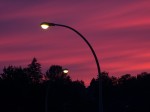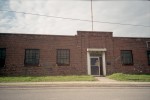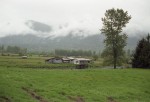Sep
29
2014

I’m sorry Wallace I’m afraid I can’t do that.
That being scan APS film in its cartridge on a flatbed scanner. So my solution take a picture it lasts longer. Not everyone will have encountered APS film so here is a little recap. APS film is smaller than 35mm film and after developing and printing it is spooled back into its cartridge never to be seen again (That isn’t strictly true but when was the last time you took a roll of film in for re-prints). Okay re-prints are where….. this could go on for a while so forget all that. APS film in cartridge, needs scanning ect. ect.
The first thing that needs to be done is to get the film out of the cartridge. Start by removing the label 
Then crack the cartridge open  which will let you get at the little film nugget inside
which will let you get at the little film nugget inside  The images on film look like this at this point.
The images on film look like this at this point. 
Which may be cool and impress cell phone photographers but the orange mask necessary from optically printing the film makes everything look sickly not to mention the fact that the image is a negative. The next thing is to take the pictures of the film, in my case I’m using a slide duplicator, a flash and the Pentax DA 35ltd macro lens all of which you should have laying around (or not).
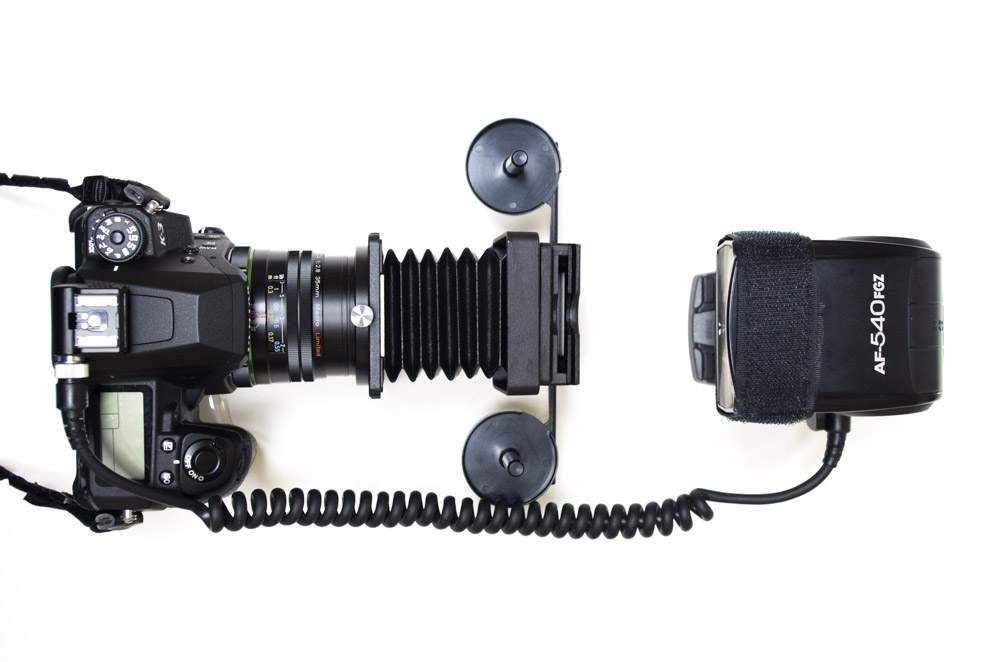
This yields a digital image that needs to be cropped and adjusted 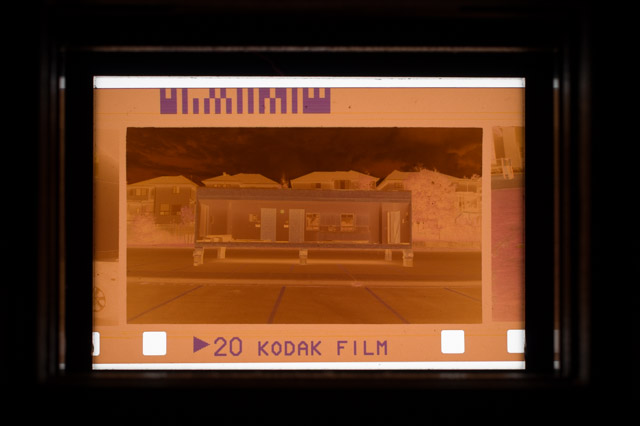 It will be a different process depending on what software you are using but it can be accomplished in Lightroom by going to the tone curve and dragging the two ends vertically to their opposite corners this has the effect of making the image a negative which it already is which makes it a positive which is good, simple right? The next thing to do is then to drag the colour balance down to eliminate what is now a cyan cast. After this its a basic matter of making adjustments to the image to make it look correct. I should add though that after the manipulation of the tone curve all the levels adjustments are reversed so things such as increasing exposure makes it darker, fun yes? After all that you should end up with an image that looks like this which will probably make you want to pick up a digital camera unless you feel photography should be a difficult process in which case carry on.
It will be a different process depending on what software you are using but it can be accomplished in Lightroom by going to the tone curve and dragging the two ends vertically to their opposite corners this has the effect of making the image a negative which it already is which makes it a positive which is good, simple right? The next thing to do is then to drag the colour balance down to eliminate what is now a cyan cast. After this its a basic matter of making adjustments to the image to make it look correct. I should add though that after the manipulation of the tone curve all the levels adjustments are reversed so things such as increasing exposure makes it darker, fun yes? After all that you should end up with an image that looks like this which will probably make you want to pick up a digital camera unless you feel photography should be a difficult process in which case carry on.

1 comment | tags: APS, film, Fuji | posted in Photography
Sep
24
2014

The Pentax Q has a tiny little mouse dropping of a sensor, 1/2.3″ (a measurement as clear in information as liters/100km would be to a horse that just found out he had one horespower) What it means though is that it only has about 1/30 of the surface area of a 35mm film frame. If you want to equate the field of views between those two disparate sizes while using the same lens you need to multiply the focal length by 5.6 on the Q. In this case the DA 40 XS would wind up being the equivalent of a 224mm f2.8 lens on 35mm film. And that is what makes this a neat little combination, it functions like a close focus telephoto and because the lens is so thin it fits the little camera nicely. Another benefit of the small sensor is that it provides greater depth of field for a given aperture. I know that sounds counter intuitive in this ‘thin is in’ shallow depth of field mad world but when you’re measuring it in millimeters having a little extra in focus without the need to stop the lens down can be a real advantage. So not only is the DA40 XS a great lens on an APSc DSLR with an adapter it fits nicely on the Pentax Q and here is another hint ‘it fits on a 35mm SLR’ too Pentax-DA 40mm F2.8 XS on film.
3 comments | tags: adapter, Digital, Pentax | posted in Cameras, Photography
Sep
22
2014

Most cameras have a mechanism to ensure that the film is advanced to the next frame before you can release the shutter again, what a shame. Yes that helps to make sure you don’t get a double exposure of a squirrel on your favourite aunt’s head but it prevents experimentation of multiple images stretched across the film. Enter the Konica 1 to save the day and put that squirrel right where it belongs and provide the ability to trip that shutter as many times as you want, film advance or not. My favourite thing to do with the Konica 1 is to take a picture then advance the film only partially and then take another each time panning from left to right. Going from left to right is important because the image is recorded upside down and backwards on the film (That’s how lenses work). The result is something like this.

And the other thing I like to do is take multiple exposures therefore collecting the light from different times all onto the same image. Like this one which represent a short drive.

More experimentations with the Konica 1 can be seen here Multiple Exposures and Multiclick
no comments | tags: film photography, Konica | posted in Cameras, Photography
Sep
20
2014

The Canon z180u was my long lens film choice on my trip to Niagara Falls. 180mm is a very long focal length for a point and shoot and the trade-off is a very slow lens aperture of 12.9 at the long end. This requires using fast film. I compromised with Kodak Portra 400 because I haven’t met an 800 ISO film I liked. Canon also wants you to be sure, of what I’m not certain.

I’m pretty sure though that the images from the Canon z180u are a little on the soft side so for anything under about 120mm I would choose a different discontinued camera to waste film in.
no comments | posted in Cameras, Photography
Sep
16
2014
These nocturne images of Barkerville B.C. were shot using my Pentax K-3. Most of the exposures were around 30 seconds a nice amount of time that doesn’t require any dark frame subtraction or the use of bulb mode.
no comments | posted in Photography
Sep
14
2014
Only 15 Polaroid spectra frames left…..ever!

no comments | tags: polaroid, Spectra | posted in Photography, Processing
Sep
10
2014


I didn’t end up finishing the roll of film in my Ricoh R1 so it did go through the security check at the airport and seems to have survived none the worse for all the radiation. As I’ve said before the Ricoh R1 has an incredibly sharp lens particularly in the center when set to 30mm not the 24mm wide angle seen in the picture above. It’s also small and pocketable. As it is one of the direct forerunners of the latest Ricoh GR digital camera its making me take a serious look at that camera too. We have reached a point in digital photography where there are many great cameras to choose from with each one having certain advantages that set them apart but they are for the most part all yielding quality images. So what would be the reason to use the R1 with film over buying a Ricoh GR? Well at around $800 for the GR that works out to around 80 rolls of film developed or 2880 frames so clearly in the long run digital would be an advantage but I’m not really likely to want to use this camera exclusively and 2880 frames might take me 5 years to shoot in that manner. You can see my dilemma, wanting something and needing it are two different things entirely.
no comments | tags: film, Photography, Ricoh | posted in Cameras, Photography, Uncategorized
Sep
7
2014

With intentions fine
you are lens cap
but upon my film exists a gap
what was seen I can not say
for on my camera you did stay
no comments | tags: olympus, poem, Video | posted in Cameras, Photography
Sep
5
2014


The Pentax smc PENTAX-DA 40mm F2.8 XS Lens is an impossibly thin pancake lens that was originally designed to go with the digital APS-c Pentax K-01 but as some people have noted it also covers a full 35mm film frame. I needed to find out for myself so I mounted it to my Pentax MZ-6 a camera that I had given away but received back and am very happy about that. I had really under rated the camera, while not built to take a beating like a professional camera, it has all the functionality of one. Back to the lens though. While the lens is very thin it shouldn’t be all that surprising as many 35mm film point and shoot cameras have similar sized lenses that are often even closer to the film plane. As a lens used with 35mm film I can say that it does an excellent job with very little vignetting which is the one thing you might expect to see when using an APS-c lens. The fact that it takes up next to no room in a camera bag and that it can be used on both film and digital really makes this a must carry lens for me.
2 comments | tags: film, lens, Pentax | posted in Cameras, Photography, Uncategorized
Sep
2
2014
no comments | posted in Painting

 which will let you get at the little film nugget inside
which will let you get at the little film nugget inside  The images on film look like this at this point.
The images on film look like this at this point. 
 It will be a different process depending on what software you are using but it can be accomplished in Lightroom by going to the tone curve and dragging the two ends vertically to their opposite corners this has the effect of making the image a negative which it already is which makes it a positive which is good, simple right? The next thing to do is then to drag the colour balance down to eliminate what is now a cyan cast. After this its a basic matter of making adjustments to the image to make it look correct. I should add though that after the manipulation of the tone curve all the levels adjustments are reversed so things such as increasing exposure makes it darker, fun yes? After all that you should end up with an image that looks like this which will probably make you want to pick up a digital camera unless you feel photography should be a difficult process in which case carry on.
It will be a different process depending on what software you are using but it can be accomplished in Lightroom by going to the tone curve and dragging the two ends vertically to their opposite corners this has the effect of making the image a negative which it already is which makes it a positive which is good, simple right? The next thing to do is then to drag the colour balance down to eliminate what is now a cyan cast. After this its a basic matter of making adjustments to the image to make it look correct. I should add though that after the manipulation of the tone curve all the levels adjustments are reversed so things such as increasing exposure makes it darker, fun yes? After all that you should end up with an image that looks like this which will probably make you want to pick up a digital camera unless you feel photography should be a difficult process in which case carry on.





















